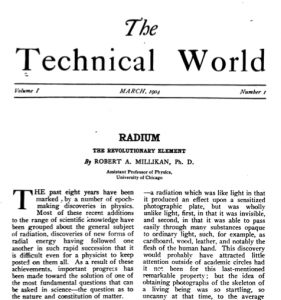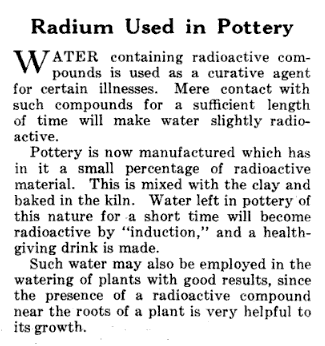
Thanks so much to those who came out to the Ann Arbor talk on Wednesday! Especial thanks to Eli, Matt, and Shirley of the Ann Arbor District Library for making the trip totally smooth; Kelly and Mike for kind hospitality; Nealie and Flex for incredible graciousness (they took me to the Henry Ford Museum! I took pictures of steam gauges!!) and everyone I’ve met in Michigan this week. I have many thanks to extend for the Dearborn trip as well (Morgan, Becca, Arica, Vicky, Hannah, et al) but let’s leave it at, if you think you ought to be thanked, you are.
I am in Charlotte now for Heroes Con! It’s all this weekend at the Charlotte Convention Center! How about that!
ANYWAY. I came across this article tonight in a 1904 issue of a magazine called Technical World. It’s a really interesting piece about the discovery and properties of X-rays and radioactivity, but these few paragraphs in particular caught my eye:
…[Radioactive] complex molecules are continually disintegrating into simpler ones, and in so doing are setting free the energy that was originally put into them when the processes of life first built them up into their complex forms…
[This energy is] enormously greater than the energies involved in any of the ordinary chemical transformations. The disintegration of a gram of uranium…sets free at least a million times as much energy as that represented in any known chemical change taking place with a gram weight of any compound substance.
The experiments of the last eight years have marked a most notable advance in science, in that they have proven the existence of this immense store of sub-atomic energy. It seems highly improbable, however, that this energy can ever be utilized on the earth to serve man’s economic needs.
…Radium may possibly prove to be of some practical value in the cure of disease, although it is too early yet to assert even this with assurance.
Nailed it.
BONUS: Another mention of radium in Popular Science, 1921:

I guess that’s one way to get a “natural, healthy glow.”

Yup! That’s the early 1900’s for ya! Theodore Gray wrote an article on it for Popular Science a while back: http://theodoregray.com/PeriodicTable/PopularScience/2004/08/2/index.html. Dude also writes about one ridiculous DIY science experiment a month.
I used to work at a research nuclear reactor at a small liberal arts college, and we had a “Revigator” in our display case. You can find out a little more at wikipedia: http://en.wikipedia.org/wiki/Radium_Ore_Revigator
I had lunch with Theo Gray (also with my son, an avid element collector and friend of Theo’s) in SF some years back; he was in town to track down the factory where the Revigator was made – the address was embossed in the clay on every radioactive jug – to see if there were radioactive traces at the site. I never heard what his results were. He owns the periodictable.com domain and sells wooden periodic tables full of elements to museums and schools. And Aris, this didn’t happen to be Reed College in Portland, OR, did it (the school Steve Jobs dropped out of)? Reed has a lot of radiation and Glen Seaborg-related oddities in the display cases far above their washing-machine-sized reactor (run by undergrads) buried deep below the campus with a conveyor assembly to move things into and out of the reactor.
My dear old Mum has an old book with an ad for radium-containing mineral water. It’s promoted as especially healthy. (I think it’s the same one that recommends cocaine against colds. Of course, after a hit of that, a cold will be the last thing on your mind.)
Actually, a little background radiation may be beneficial: http://en.wikipedia.org/wiki/Hormesis
Oops, sorry, meant to paste this link: http://en.wikipedia.org/wiki/Radiation_hormesis
Doug, I’m pretty sure Reed is the only liberal arts school with their own reactor. We’re all jealous.
See also prewar red-orange fiesta ware. They used a uranium oxide glaze.
http://www.orau.org/ptp/collection/consumer%20products/fiesta.htm
http://www.youtube.com/watch?v=fJf-VpR7foM
Don’t forget the very sad tale of the Radium Girls, the young women who painted watch dials and hands with Radium in NJ from 1917-1926
http://en.wikipedia.org/wiki/Radium_Girls
Radiation was still being used for dubious health benefits as late as the 1940s or maybe 50s. When my dad was a kid, he was given some kind of radiation treatment for tonsillitis. Fast forward a few decades, and he gets a letter from the hospital it was done at all those years ago, saying essentially “Hey, remember that radiation treatment we gave you? Turns out it wasn’t such a great idea, and you’re now at an extremely elevated risk for thyroid cancer. Might want to get that checked out. Oops, our bad!” And sure enough, he did get it, though at least that’s one of the more easily treatable kinds of cancer.
We enjoyed showing you around. Let us know next time you’re coming our way and we’ll take you to the airplane museum. 🙂
Many old buildings contain tiles with radioactive glaze. I’ve now encountered a second one in Seattle. The first was an old brick apartment on Capitol Hill, now gone. A fellow hobbyist was working with a weird device which was inexplicably radioactive, but soon we tracked it down to the greenish-brown tiles behind his kitchen sink!
Years later I was demonstrating a GM counter in an old building where the walls in the hallways had a 2-tone color motif in glazed brick. The cream/brown tiles were inert, but sure enough, the slightly yellow-brown tiles had significantly above background count. Seems that in pre-WWII times, desirable yellow color for ceramic glazes came from salts of uranium.
The Oak Ridge radiation museum has an enormous amount of online stuff; just their page on quack cures is gigantic:
http://www.orau.org/ptp/collection/quackcures/quackcures.htm
http://www.orau.org/ptp/museumdirectory.htm
Turns out that drinking radium may get you a personalized obituary in Time – “…holes were actually forming in his skull”
http://www.time.com/time/magazine/article/0,9171,743525,00.html
Radium suppositories were popular too, I gather.
…and a lead-lined coffin to boot.
http://www.alleghenycemetery.com/images/newsletter/newsletter_XIII_1.pdf
The Technical World article is fascinating to read from today’s perspective. Being from 1904, it would have been a mere seven years after the discovery of the electron and, respectively, fifteen and twenty-eight years before the discoveries of the proton and neutron.
In 1946, my mom had radiation treatment to her thyroid to clear up her skin. It worked — but in 1966 she had radical surgery to remove that cancer-ridden gland. Luckily for my dad and for us kids (12, 10, 4, and 2 at the time) she survived and enjoyed another 45 years.
And people complain about clinical trials taking so long…